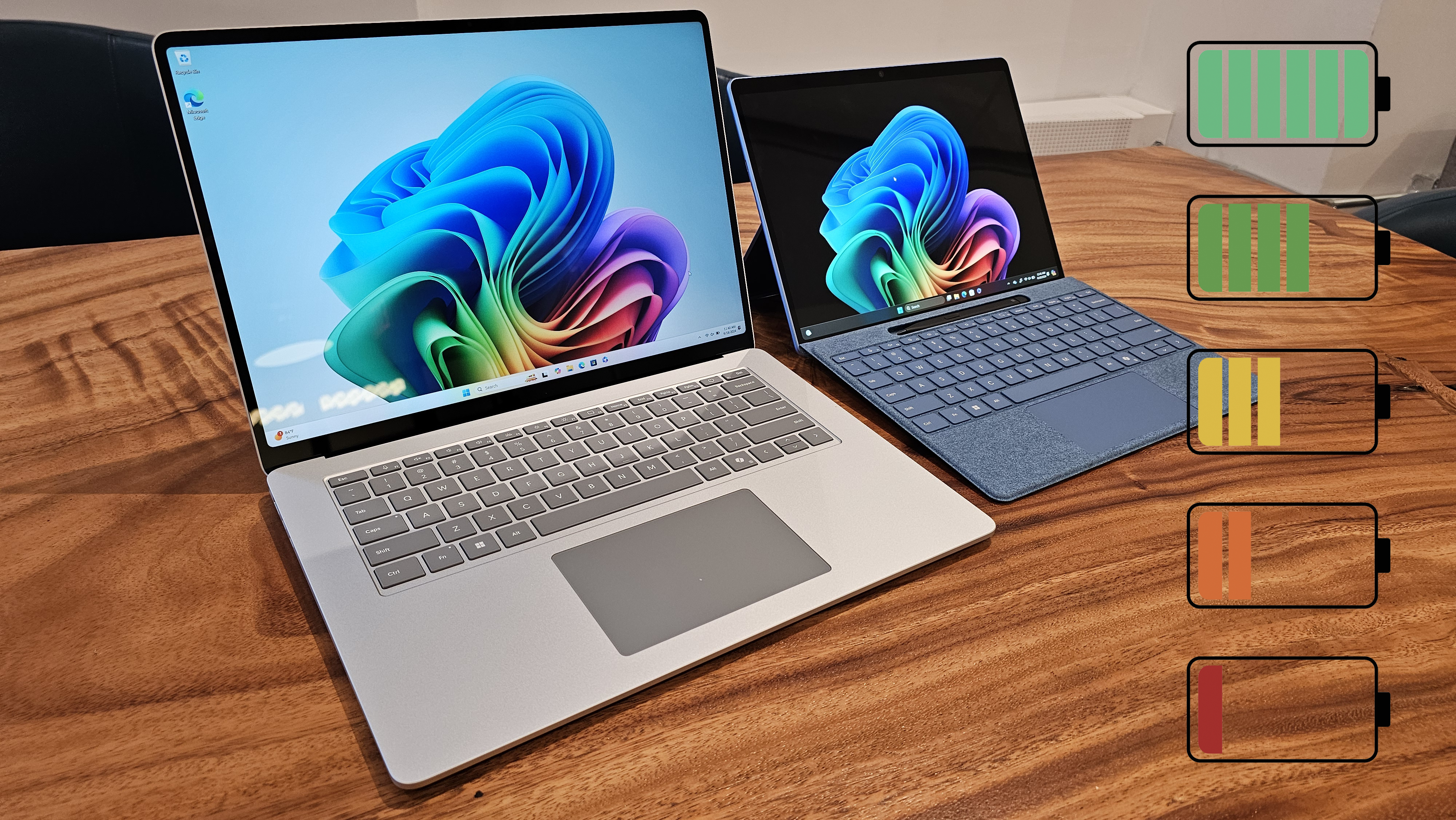We’re in the middle of testing a number of Windows laptops with Qualcomm’s new Snapdragon X Elite CPUs inside. This is a major moment in PC history, becauseMicrosoftis pushing this new generation of computers so hard, calling themCopilot+ PCsand giving them exclusive features that Intel and AMD-powered laptops won’t get for months.
Microsoft and Qualcomm have tried to make Windows on Arm laptops a successful part of the PC market for many years now and it has never worked out for a variety of reasons we could spend a whole article on – compatibility issues, mediocre performance and high prices. Snapdragon Elite X systems promise to deliver really strong AI performance, run most Windows apps well and last all-day on a charge. So what about that last one?

To find out just how long the various Copilot+ PCs can go unplugged, we ran our battery test, which involves surfing the web over Wi-Fi at 150 nits of brightness, on four different laptops with Snapdragon Elite X chips. We then compared the results to those we have gotten using the same test on Intel Meteor Lake or Apple M2 / M3 laptops of recent vintage.
Let’s have a look at the Snapdragon laptops first:
So we’re seeing 12 hours on Surface Pro 2-in-1 and 14.5 to 15.5 hours on the three laptops. The Surface Pro is really at the bottom of this pack, perhaps because its OLED screen gulps power or perhaps it just has other components that require more juice than the traditional laptops on this list.
Incidentally, this 2024 Surface Pro has almost identical battery life to the Surface Pro 9 from a couple of years ago. Powered by an earlier Arm chip, the Microsoft SQ3, that 2-in-1 endured for 11 hours and 50 minutes on our test.

While 14 to 15 hours of battery life for the laptops is really good, it only exceeds the longest-lasting x86 laptops we (or our colleagues) have tested in recent years. And it still falls behind the current crop of MacBooks.
Get Tom’s Hardware’s best news and in-depth reviews, straight to your inbox.
As you can see in the table below, the MacBook Pro 14 and 16 lasted longer than 17 hours on our test. Of course, it helps Apple that these laptops have humongous 70 and 100 Whr batteries. None of the Copilot+ PCs we tested has more than a 66 Whr battery with most under 60 Whr. So, perhaps with a battery capacity similar to the MacBook Pro’s, the Snapdragon laptops would top the list.
None of the laptops with Intel / AMD CPUs that we or our colleagues at Laptop Mag (who use our same test) benchmarked in the last year exceeded 14 hours of battery life. However, there were several systems that had 10+ hours of endurance and a few that got 12+.
For example, theThinkPad X1 Carbon (Gen 11)and its Intel Core i7-1335U CPU went for 13 hours and 45 minutes on our test. TheAsus Zenbook 14 OLEDwith Core Ultra 7 155H, one of thebest Ultrabooks, managed 12 hours and 21 minutes, partly on the strength of its 75 Whr battery. Unfortunately, the newer,12th-gen ThinkPad X1 Carbondidn’t crack 10 hours, but it’s possible that the high-res, 120 Hz panel on our review unit hurt its chances.
What about AMD-powered laptops? In our original version of this article, we left them out of the table, not because they aren’t good or we don’t like them, but because we haven’t tested any in the past year that exceeded 9 hours of battery life. However, our colleagues at Laptop Mag did get two AMD-powered laptops in the past 12 months that were in that range. The Asus Zenbook 14 OLED (UM3402Y) managed 11 hours and 13 minutes with its Ryzen 7 7730U CPU and 75 Whr battery. The HP Envy x360 2-in-1 with the same processor and a 51 Whr battery lasted a very modest 9 hours and 17 minutes.
Obviously, some of the Intel / AMD laptops benefit from having higher-capacity batteries, but that’s not always the case. The ThinkPad X1 Carbon (Gen 11) has a 57 Whr battery so it got an average of 14.5 minutes of battery life per Whr. The Surface Laptop 15 has a 66 Whr battery which gives it 13.2 minutes per Whr. And the Surface Pro’s 53 Whr battery leaves it was 13.9 minutes per Whr.
Historically Higher Numbers
By the way, if you go back several years, we’ve seen a few models with stronger battery life than any we’ve tested in the last 12 months. In 2020, we tested a Lenovo Yoga Slim 7 with an AMD Ryzen 7 4800U CPU and a 60 Whr battery that endured for 17 hours and 31 minutes. That same year, theAsus ROG Zephyrus G14with a Ryzen 4900HS CPU and RTX 2060 graphics and a huge 76 Whr battery lasted 11 hours and 32 minutes on a charge.
Also, in 2020, Laptop Mag tested theDell Latitude 9510with a Core i7-10810U CPU and an 88-Whr battery that delivered 18 hours and 17 minutes of battery life. The ruggedGetac S410packs three batteries and, in 2022, it lasted an epic 29 hours and 38 minutes with a Core i7-1185G7. In 2018, theLenovo ThinkPad T480, which I personally reviewed, lasted 17 hours and 19 minutes with its Core i5-8350U CPU and optional, 72-Whr battery.
One huge drawback to many of the laptops I named above is their weight. The Yoga Slim 7 is 3.5 hours as is the ROG Zephyrus. TheDellLatitude tipped the scales at 3.7 pounds, the Lenovo ThinkPad T480 weighed 3.98 pounds and the Getac was a beefy 5.2 pounds. Those larger batteries added to the weight, but for many people, the benefit was worth the added bulk.
What to Expect for Snapdragon Elite X
So, ultimately, it seems like you can expect maybe 2 to 4 hours more endurance on a Snapdragon-powered laptop than on one of the longest-lasting Intel / AMD systems today. That’s a huge convenience, but it’s not a game-changer.
Ultimately, 14 or 15 hours of battery life is likely to get you through one solid workday and the beginning of another after all is said and done. When you pump up the brightness and do more demanding tasks than we do in our battery test, the endurance will shrink by a few hours. Truly game-changing battery life would be enough to last you through two full workdays without even thinking about charging. That would probably be 22 hours of endurance on our tests, but I’d be impressed by anything over 20.
I’d like to be able to take my laptop to the airport, use it to work at the gate for 2 hours before boarding, board a 15-hour flight to Taiwan where I also use it most of the time. Then I’d like to use it for several hours after I land while I’m sitting around the hotel lobby waiting for check in time.
But, on the bright side, in 2024, most of those locations have power outlets, including the plane. Unless you’re out doors camping or in the park, you can usually find a place to plug in.
So do you need more than 10 to 12 hours of endurance? And, if so, is another 3 hours enough of a delta to affect your buying decision? If it is, within the next four or five months, we’ll have new laptops based on Intel Lunar Lake and AMD Strix Point that could bring x86 to parity.
Avram Piltch is Managing Editor: Special Projects. When he’s not playing with the latest gadgets at work or putting on VR helmets at trade shows, you’ll find him rooting his phone, taking apart his PC, or coding plugins. With his technical knowledge and passion for testing, Avram developed many real-world benchmarks, including our laptop battery test.